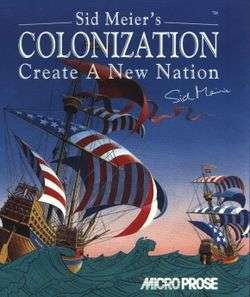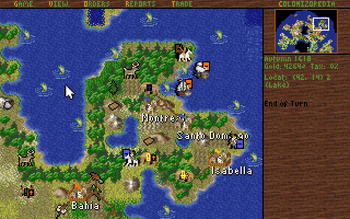Sid Meier's Colonization
| Sid Meier's Colonization | |
|---|---|
 | |
| Developer(s) | MicroProse |
| Publisher(s) | MicroProse |
| Designer(s) | Brian Reynolds, Sid Meier |
| Series | Civilization |
| Platform(s) | Amiga, DOS, Windows, Macintosh, Linux |
| Release date(s) | 1994, 1995 |
| Genre(s) | Turn-based strategy |
| Mode(s) | Single player |
Sid Meier's Colonization is a computer game by Brian Reynolds and Sid Meier released by MicroProse in 1994. It is a turn-based strategy game themed on the early European colonization of the New World, starting in 1492 and lasting until 1850. It was originally released for DOS, and later ported to Windows 3.1 (1995), the Amiga (1995), and Macintosh (1995).
Colonization is much like a more developed version of Sid Meier's previous game Civilization (1991) in visual design and handling, but the two have marked differences in gameplay. Instead of forging a nation from nothing, the player manages the cross-Atlantic expansion of an established one in the service of the Crown. As the colonies become more self-sufficient their subservience shifts from boon towards bane, and to win the player must ultimately declare independence and defeat the Royal Expeditionary Force in battle.[1]
Gameplay


The game begins in 1492. The player controls the colonial forces of either England, France, The Netherlands, or Spain; the other powers are then played by the computer. The choice of nation is important, as each nation has unique abilities that favor certain strategies. There is a choice between a historical map (America) or a randomly generated map (the New World); the randomly generated map shifts the focus of the game toward exploration—in this mode the game has considerable replay potential.
The journey begins with two units traveling on a ship to the new world; as the ship moves into the unknown, the map is revealed. Subsequently, the New World is discovered, the Indians are met, a colony is built, colonists begin to change the land to be more productive, the ship is sent back to Europe to collect more colonists, any superfluous items are sold and the exploration of the world begins. The game revolves around harvesting food and manufacturing and trading goods. Resources gleaned from the land are converted into commodities and either used or sold (usually back in Europe). The prices of commodities fluctuate depending upon supply and demand. The more of a commodity is sold by the colonial powers, the less the markets will be willing to pay for them. With money, a player is able to buy goods, recruit new colonists, or buy ships or artillery. While maintaining an income, the player is also required to protect his colonies from potential invasion by equipping and stationing soldiers. Moreover, the player is required to manage his citizens effectively, educating the populace in various skills to increase their productivity in areas such as farming, gathering of resources, or manufacturing.
There are four European powers available. The player may choose to play as a colonial leader of any one of these powers, and the remaining three will be the computer-controlled competitors. Each power has certain bonuses that make them unique and different from each other. Aside from European colonial powers, the NPC powers include eight Native American tribes, in four main categories. Each Native American settlement can convert one regular colonist into a specialist. More advanced tribes (Incas and Aztecs) live in larger cities. Analogous to technologies in Civilization, social and industrial advances are achieved by the addition of "Founding Fathers" to the "Continental Congress", which are gained by generating a sufficient number of "Liberty Bells" through the colonial pride of settlers. These are all named after real historical figures, such as Francisco Vásquez de Coronado and Pocahontas.
One main driving impulse in Colonization is the harvesting of natural resources, such as lumber (for building), ore (for manufacturing), and food (for population growth). Squares on the map have basic values of resource output (depending on the type of terrain and if a river runs through it), but certain 'prime' squares have double or higher output values. Inside the town, any colonist can work the field for the basic resource output. Specially trained units can typically harvest twice as much. There are three areas of employment in the Colonization world: primary resource gatherers, secondary resource manufacturers, and the more specialized units such as soldiers, statesmen, pioneers, Jesuit missionaries, and preachers. The geography of the land determines the productivity of a colony. For instance, some squares produce great amounts of food, while others may produce greater amounts of ore or silver. Thus it becomes necessary to link various colonies together via roads (roads grant increased mobility of units) or sea trade routes, to transport goods from colonies where there is excess to those where there is demand.
Development
Tommo Inc. purchased the rights to this game and digitally publishes it through its Retroism brand in 2015.[2]
Reception
In 1996, the game was ranked the 4th best game of all time by Amiga Power.[3]
Remake
Civilization IV: Colonization is a Firaxis remake of Colonization, using an upgraded Civilization IV engine. The game features original gameplay, 3D graphics, an updated AI, and multiplayer support. It was released for the PC on September 22, 2008.
See also
- FreeCol, an open source Colonization clone
References
- ↑ https://www.gog.com/game/sid_meiers_colonization
- ↑ "Purchase Agreement between Atari, Inc. and Rebellion Developments, Stardock & Tommo" (PDF). BMC Group. 2013-07-22.
- ↑ Amiga Power magazine issue 64, Future Publishing, August 1996